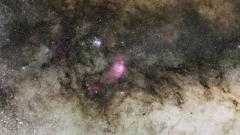Lagoon Nebula
| emission nebula | |
|---|---|
| H II region | |
 M8, the Lagoon Nebula | |
| Observation data: J2000 epoch | |
| Right ascension | 18h 03m 37s[1] |
| Declination | −24° 23′ 12″[1] |
| Distance | 4,100[2] ly (1,250 pc) |
| Apparent magnitude (V) | 6.0 |
| Apparent dimensions (V) | 90 × 40 arcmins |
| Constellation | Sagittarius |
| Physical characteristics | |
| Radius | 55 × 20 ly |
| Designations |
Sharpless 25, RCW 146, Gum 72 M8 contains: NGC 6523, NGC 6530,[1] Hourglass nebula[3] |
The Lagoon Nebula (catalogued as Messier 8 or M8, and as NGC 6523) is a giant interstellar cloud in the constellation Sagittarius. It is classified as an emission nebula and as a H II region.
The Lagoon Nebula was discovered by Giovanni Hodierna before 1654[4] and is one of only two star-forming nebulae faintly visible to the naked eye from mid-northern latitudes. Seen with binoculars, it appears as a distinct oval cloudlike patch with a definite core. A fragile star cluster appears superimposed on it.
Characteristics
The Lagoon Nebula is estimated to be between 4,000-6,000 light years from the Earth. In the sky of Earth, it spans 90' by 40', translates to an actual dimension of 110 by 50 light years. Like many nebulas, it appears pink in time-exposure color photos but is gray to the eye peering through binoculars or a telescope, human vision having poor color sensitivity at low light levels. The nebula contains a number of Bok globules (dark, collapsing clouds of protostellar material), the most prominent of which have been catalogued by E. E. Barnard as B88, B89 and B296. It also includes a funnel-like or tornado-like structure caused by a hot O-type star that emanates ultraviolet light, heating and ionizing gases on the surface of the nebula. The Lagoon Nebula also contains at its centre a structure known as the Hourglass Nebula (so named by John Herschel), which should not be confused with the better known Hourglass Nebula in the constellation of Musca. In 2006 the first four Herbig–Haro objects were detected within the Hourglass, also including HH 870. This provides the first direct evidence of active star formation by accretion within it.[2]
Gallery
-

Image taken by the Wide Field Channel of the Advanced Camera for Surveys on Hubble.
-
.jpg)
Infrared Lagoon Nebula.
-

Central region of the Lagoon Nebula, showing the Hourglass Nebula to the right.
-
.jpg)
The Lagoon Nebula
Credit: ESO/S.Guisard. -

Three images from the ESO GigaGalaxy Zoom project.[1]
-

Waves breaking in the stellar lagoon
Credit: NASA, ESA. -
Dive into the Lagoon Nebula.
- ^ The images show the sky at different levels: from the view seen by the unaided eye to one seen through an amateur telescope, with a final zoom in onto the Lagoon Nebula as seen through a professional telescope.
In fiction
See also
- Lagoon Nebula in fiction
- List of Messier objects
- List of nebulas
References
- ↑ 1.0 1.1 1.2 "SIMBAD Astronomical Database". Results for M8. Retrieved 2006-11-15.
- ↑ 2.0 2.1 Arias, J. I.; Barbá, R. H.; Maíz Apellániz, J.; Morrell, N. I.; Rubio, M. (2006). "The infrared Hourglass cluster in M8". Monthly Notices of the Royal Astronomical Society 366 (3): 739–757. arXiv:astro-ph/0506552. Bibcode:2006MNRAS.366..739A. doi:10.1111/j.1365-2966.2005.09829.x.
- ↑ "SIMBAD Astronomical Database". Results for Hourglass Nebula. Retrieved 2006-12-22.
- ↑ http://messier.seds.org/m/m008.html
External links
| Wikimedia Commons has media related to Lagoon Nebula. |
- Breaking Waves in the Stellar Lagoon — ESA/Hubble Photo Release
- Messier 8, SEDS Messier pages
- NightSkyInfo.com - M8, the Lagoon Nebula
- Messier 8, Pete's Astrophotography Gallery
- Messier 8, Lagoon Nebula, Map
- Astronomy Picture of the Day (APOD): Lagoon Nebula
- The Scale of the Universe (Astronomy Picture of the Day 2012 March 12)
- The Lagoon Nebula on WikiSky: DSS2, SDSS, GALEX, IRAS, Hydrogen α, X-Ray, Astrophoto, Sky Map, Articles and images
- Lagoon Nebula (M8) on Constellation Guide
| ||||||||||||||
| ||||||||||
| ||||||||||
| ||||||||||||||
